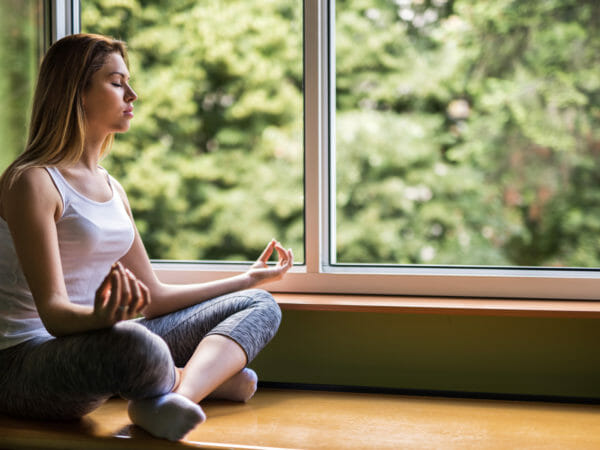Simple and Best Breathing Exercises for Anxiety, Sleep, and Much More!
Breath. We all do it, but for some reason, we never really think about it until it gets difficult. But do you know there’s a very long breath control tradition which can change the quality of your life? Breathing exercises and respiratory techniques benefit all of your body, mind, and psychology. It might even be helping your soul according to some traditions.
Just like any other exercise, breathing exercises begin slowly. But your breathing becomes toned and tuned with practicality and consistency. Why does it matter? Since they will strengthen your concentration, develop your strength and stamina, and help alleviate stress.
Think of Lamaze breathing during the work of a woman. This is just one example of how breathing techniques can help in an emergency. There are also some that can help you out of tough situations, such as anxiety, insomnia, or physical illness.
And you can draw on breathing exercises anywhere, just like regular breathing. They ‘re only taking a few minutes of your time, and all it takes is a little focus. With the help of specific ones, including 4-7-8 breathing techniques and pranayama, you can take control of your well-being. All by breathing.
What Are Breathing Exercises?
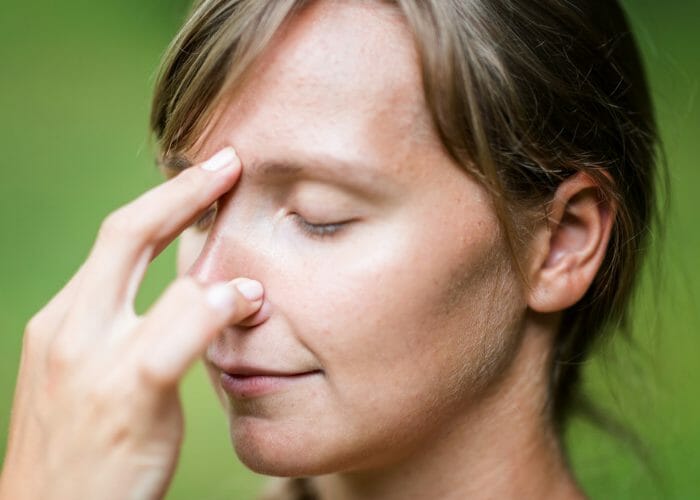
Controlled breathing exercises have been around for millennia in other parts of the world. However, they are only recently gaining global recognition for helping people take control of their sleep patterns, anxiety attacks, weight problems, stamina, COPD, and other issues.
Normally, our breaths are shallow and extend only into our lungs, and then out again. The exception to this is during sleep. We are most at rest when we sleep and thus, we automatically breathe very deeply. Specifically, we breathe deep into our abdomen. This is called diaphragmatic breathing. Breathing exercises help us focus on deepening our breaths into our abdomen while we’re awake.
There are many breathing techniques to help us relax, heal our bodies, energize our minds, reduce stress, and the list goes on. They are great remedies to have in your arsenal of healthy habits so that whenever you are too stressed, too tired, too under the weather, or tooanything, you can reach for a breathing technique for an easy solution.
Some of the positive benefits of deep breathing exercises include improved core muscle stability, lowered blood pressure, lowered heart rate, and an overall feeling of personal satisfaction.[1] There are a number of physical activities that include breathwork as part of their practice, including tai chi, yoga, and pilates.
Who should practice breathing techniques?
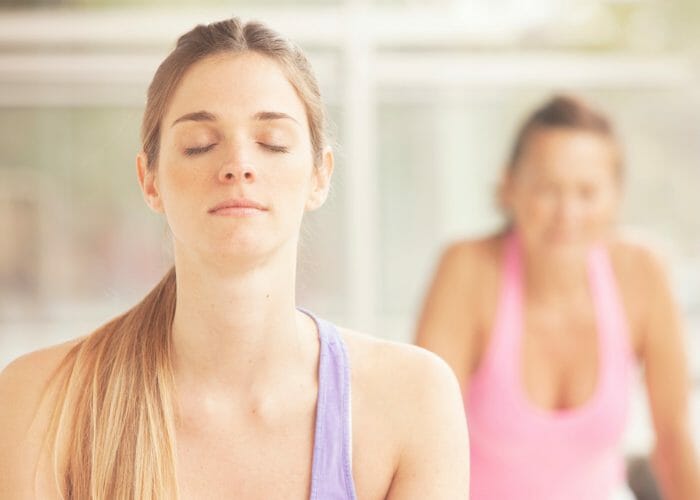
As living organisms, we must breathe in order to live. Every time we take a breath, the oxygen we breathe goes to all of our organs, tissues, and cells as nutrients.[2] Deep breathing techniques go one step further to help calm and de-stress the parasympathetic nervous system (PNS) by delivering oxygen.[3] The PNS relaxes the body and slows many high-energy functions in the body and brain.
Breathwork is useful in many different situations. Some people try it to increase focus, get through a difficult moment, or simply to relax. Here are a few situations in which breathing exercises can really help improve your health and manage various health conditions:
- You have stress/stress-related issues – Deep breathing techniques help calm, relax, and de-stress while invigorating the nervous system by delivering oxygen.[4] It relaxes the body and slows many high-energy functions in the body and brain.
- Suffer from asthma/COPD – Breathing exercises can help build your lung strength and normalize your breathing patterns.
- Experience anxiety or panic attacks – Developing an ongoing deep breathing practice can help you to lengthen your breaths during a panic attack to avoid hyperventilation.
- Have facial paralysis – There are some geared towards utilizing your face muscles to help rehabilitate them after any type of accident or illness.
- Practice mindfulness – Deep breathing techniques can help you center and take note of your current surroundings to help you develop better processes throughout the day and your life.
So, who needs breathing exercises? Well, everyone basically. No matter how old you are, or the lifestyle you lead, you can start reaping the rewards of regular practice. Practicing them ensures your body gets enough oxygen, and it also helps your body de-stress and maintain balance. As a result, developing a breathing practice will encourage better health, both physically and mentally.
Singers, athletes, divers, and astronauts all rely on breathwork to develop lung capacity and better breathing habits – so you’re in good company if you start making it a habit yourself!
10 Powerful Breathing Exercise Benefits
There is no shortage of benefits to deep breathing. However, when you develop a daily breathwork practice, you will notice the difference it can make in your life. You’ll notice you breathe easier and have more energy. Read on to explore how deep breathing exercises can help you.
1. Reduces anxiety
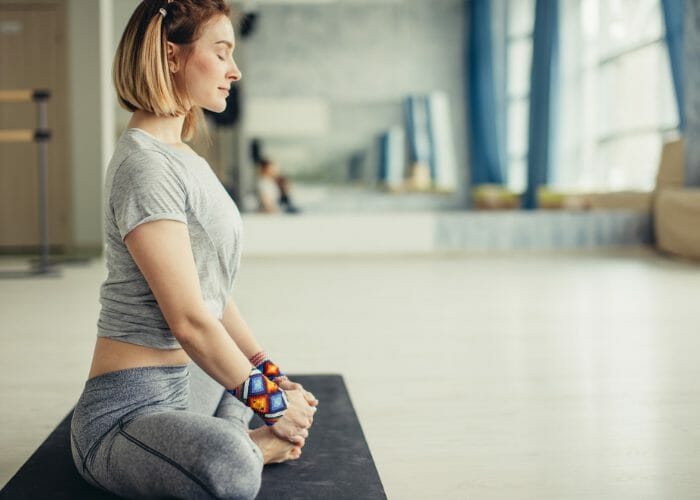
Regular deep breathing practice for at least 10 minutes per day helps you develop a mechanism to use during states of anxiety. In a study conducted on 100 high school children, they were given 45 days of guided deep breathing practice for 30 minutes each day.[5] The results showed a great reduction in their anxiety levels.[6] Furthermore, the study indicated that the students can incorporate the deep breathing exercises into their daily activities to help them perform better.[7]
In another study, 36 university students were divided into three groups to determine whether one deep-breath training followed by daily independent practice could reduce test anxiety.[8] The results determined that daily deep breathing exercises substantially helped to reduce test anxiety for the participants. They also led participants to think more positive thoughts about themselves.[9]
2. Improves sleep
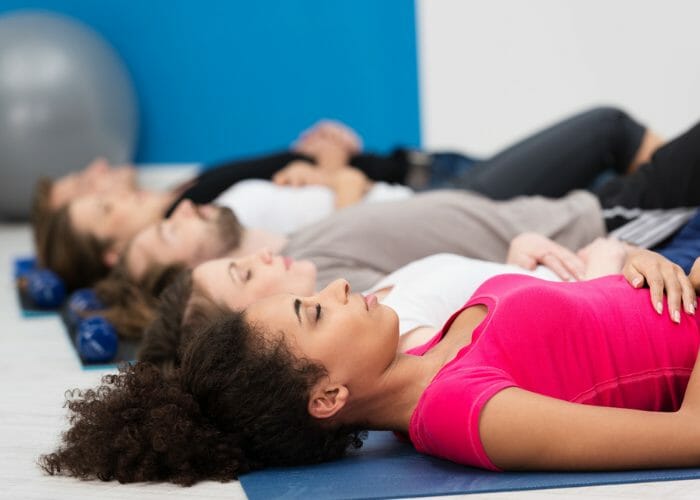
Why? Because deep breathing allows you to calm your nerves in a real, physical way. It transmits to the brain that everything is okay, and the rest of the body follows suit. Famously, there is a technique called 4-7-8 breathing (which we outline the steps to in the next section) that encourages deep relaxation of our muscles and our minds. It can be used when you suffer from insomnia but should also be used as part of a regular breathing practice.[10]
3. Reduces stress
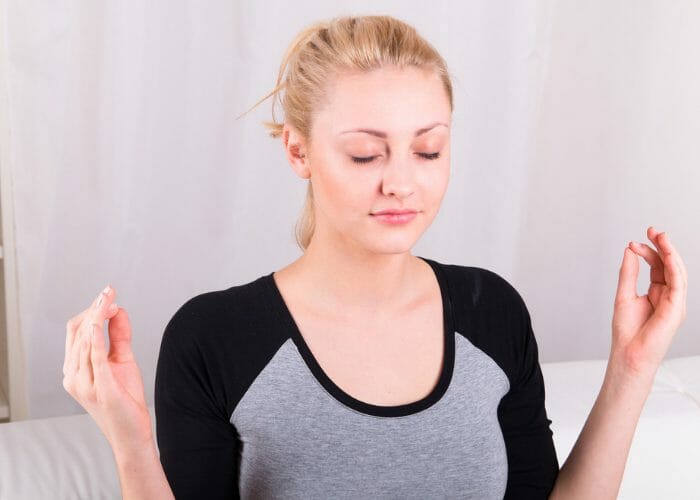
Physically, deep breathing exercises have an objective physical response[11] that proves their capacity to decrease stress. In a study of 38 university students, those who did one 90-minute, guided deep breathing session once a week showed reduced levels of salivary cortisol and a lower heart rate.[12]’[13] In addition to these objective criteria, the subjects also self-reported that they felt more relaxed and less stressed.[14] This could have long-term consequences on that particular type of anxiety in the future.
4. Helps you relax
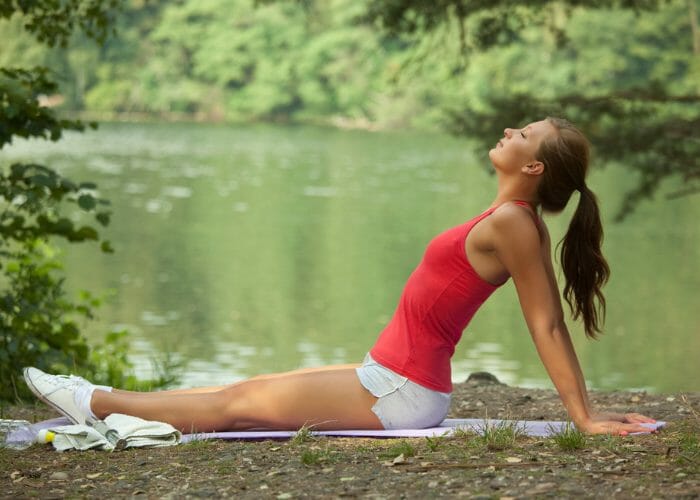
Breathing deeply in a regulated practice relaxes your muscles. When you take slow, steady breaths, your brain gets the message that all is well, and your body automatically responds by relaxing the muscles.[15]
In one study, it was shown that deep breathing exercises reduced oxidative stress in muscles after working out, lowered cortisol levels and increased melatonin levels.[16] So, doing some after working out actually helps your muscles, brain, and tissues relax!
In addition, using a deep breathing exercise with a point-technique of relaxing individuals muscle groups with each set of inhales and exhales can increase your body’s relaxation function. The practice can become a useful part of helping you relax.
5. Increases lung capacity
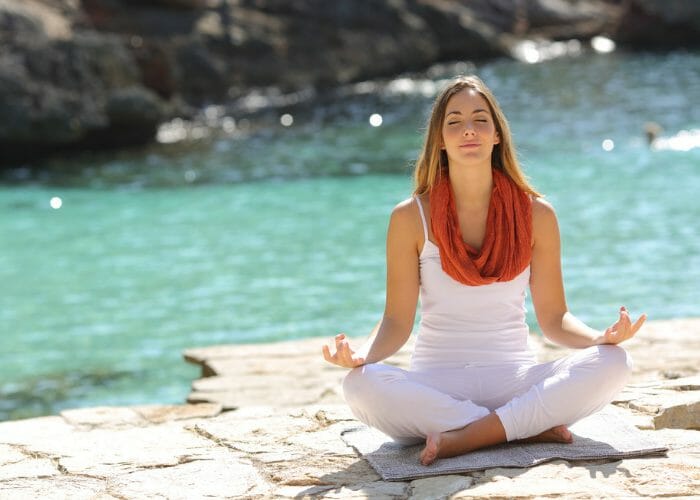
For singers, athletes, as well as people with lung conditions, regular deep breathing techniques can help to increase and strengthen your lung capacity.[17] A study on elderly smokers proved that deep breathing techniques actually build lung function and increased respiratory strength.[18]
6. Weight loss
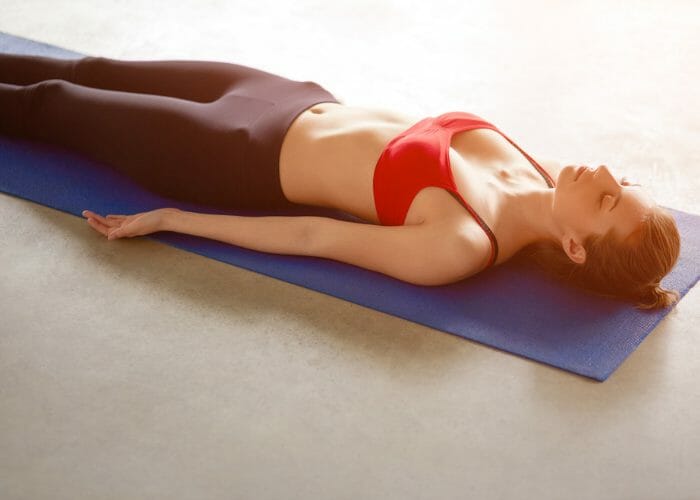
How can breathing help you lose weight? The two seem totally unrelated, but they’re actually connected! Deep breathing calms our parasympathetic nervous system, which in turn, tells our brain that all is well. And when we think it, we believe it.
In one study, deep breathing exercises were assigned to 60 obese people to assess its value as part of a dieting regimen.[19] The participants were asked not to follow any specific diet for two months. The results showed two things: first, the breathing training resulted in weight loss. Second, that the results were lasting, even though none of the participants followed a set weight loss plan.[20]
These results also led the scientists to the conclusion that obesity leads to the creation of a negative attitude, psychological stress, and an increase in psychological disorders.[21] The breathing practice helped the participants feel better about themselves, which also attributed to weight loss.
7. Mindfulness
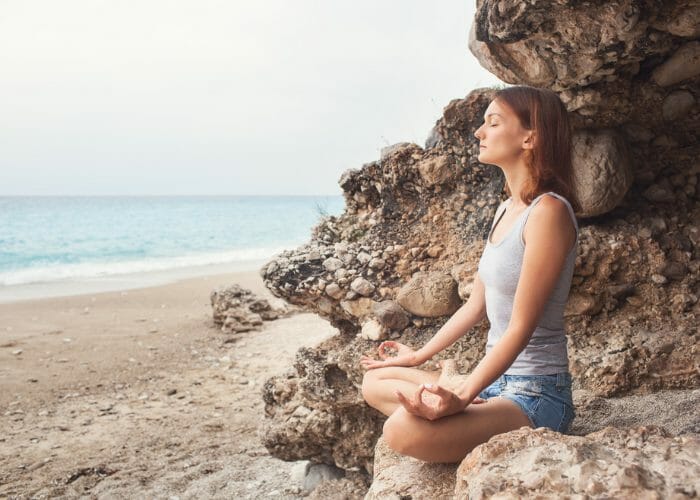
Deep breathing exercises can be used to encourage a mindful approach to stress-relief.[22] Mindfulness, or decentering, requires us to objectively take note of ourselves as we go through our day.[23] It encourages an acceptance-based intervention of the struggles we face on a regular basis.
So, training ourselves in a daily deep breathing practice can help us focus our intentions towards mindfulness in all the tasks that we do throughout the day.
This type of breathwork is very compatible with mindfulness, as it is one of the best ways to begin incorporating deep breathing techniques during daily activities. As deep breaths work to calm our nerves and tune into our parasympathetic nervous system, we become calmer and more accepting of the things that we cannot control or change in our lives. As a result, it helps us find satisfaction with our lives and the progress we make in life.
8. Increases alertness/concentration
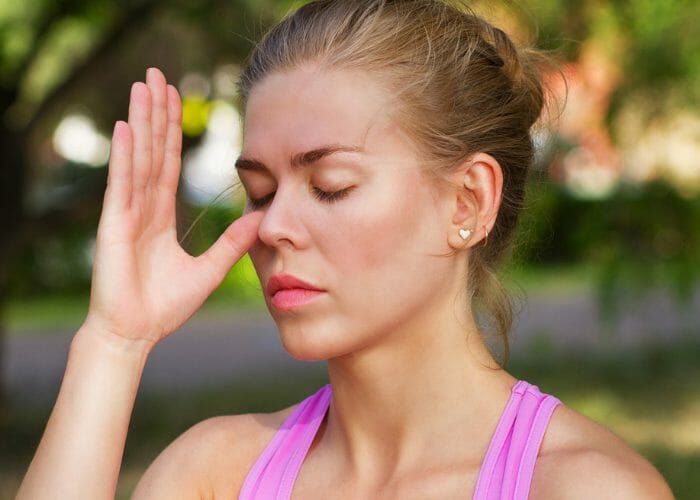
Aside from deep breathing, there are also many types of breathing techniques that involve short pulses of breath during the exhale that can immediately burgeon your energy and alertness levels. These can help you improve your focus, get more done, and feel alert and awake in seconds.
9. Helps with incontinence and bowel movements
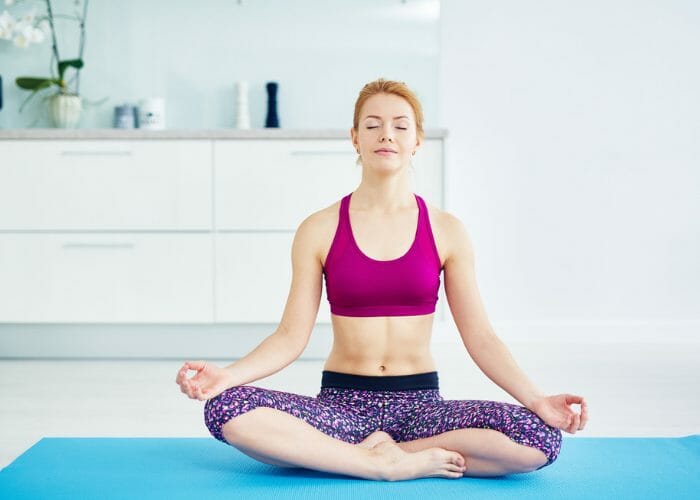
Breathing deeply as a daily practice has been proven to help relieve symptoms of incontinence and gastrointestinal issues. It helps rebuild the pelvic floor.[24] These exercises have been proven effective from both a sitting or prone position to achieve abdominal relaxation.[25]
In a study of incontinent patients conducted over the course of one full year of deep breathing practice, the results were quite astonishing. 20 out of 24 patients were cured of their urinary incontinence, 13 out of 19 participants studied did not get a UTI, and all 15 patients were cured of constipation.[26]
10. Lowers heart rate and blood pressure
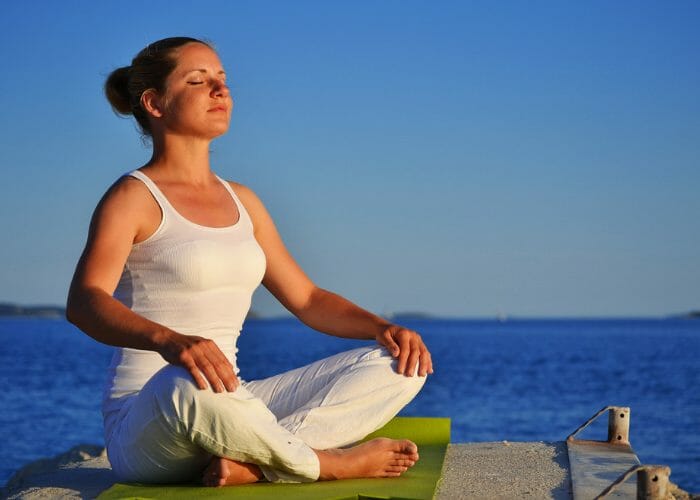
A consistent deep breathing practice has shown evidence of lowering systolic blood pressure and improving our heart rate variability.[27]
9 Simple Breathing Exercises
One important thing to remember is that you can do breathing exercises, truly, anywhere. The point is to practice while you are moving, walking, shopping, exercising, working, showering – basically while doing any other activity.
After a few weeks of daily practice, you will see additional benefits from any or all of these breathing techniques. You’ll notice you are more balanced and calm. If you once had cold hands, your hands will be warm. You won’t get nervous or anxious about little things. Your physical body will respond to your breath management in surprising and wonderful ways.
Each of the breathing exercises in this guide requires you to follow three basic steps at the beginning of your practice:
- Firstly, unless otherwise stated, the exercises encourage deep breathing through the nose only.
- Secondly, practice should be done in a seated position, either on the floor or in a chair, keep your spine in a comfortable but upright S-curve.
- Thirdly, observe your current natural breathing pattern as it is, without changing or lengthening it – just quietly observe it.
Following that, you may begin your specific breathing practice for the day using our guidelines below.
1. Basic Diaphragmatic Breathing
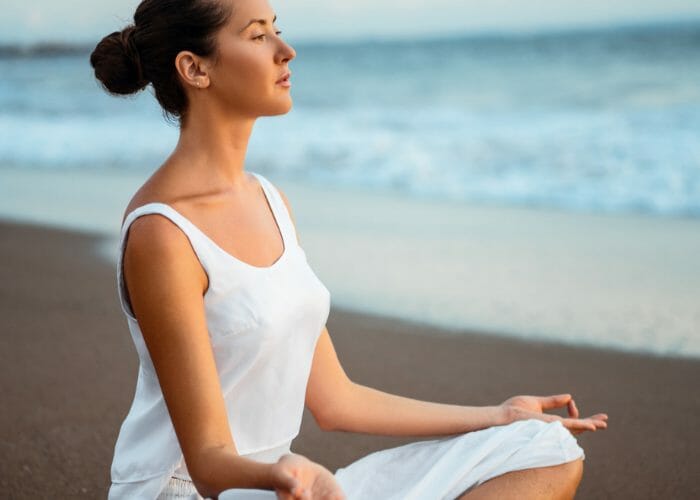
- Try this if you want to learn to control your breathing
- Level of difficulty: beginner
How this breathing exercise will help:
Deep breathing exercises (also known as diaphragmatic breathing) involve the diaphragm. When you take a deep inhale (just once or in repetition during a breathwork practice), your diaphragm moves down and pushes the stomach out. This is diaphragmatic breathing.
There are three parts to doing deep, or diaphragmatic, breathing. To begin a deep breathing practice, start by observing your breath. This requires you to be aware of your current breathing. Is it shallow, smooth, or erratic? deep? Perhaps it’s short and fast? Simply take note.
This is the easiest breathing technique to incorporate into your daily activities, and it starts with notions of mindfulness and the objective breath.
Steps for how to start:
- Draw in a deep breath and pay attention to your expanded belly area. You can place your hand on your tummy during this portion of the breathwork to take note that your stomach is expanding.
- Then, allow the air to expand into your rib cage. Place your hand along your rib cage on the side of your body, and note that your rib cage is expanding.
- Finalize your deep inhale by filling all the way up with air. Don’t allow your shoulders to rise as you inhale, as breathing practice remains in the torso of the body only.
2. Conscious Connected Breathing

- Try this if you want to calm your “monkey mind” – your unsettled and restless mind
- Level of difficulty: Beginner
How this breathing exercise will help:
This breathing technique comes recommended to WellMe by the President of International Breath Coaching Federation, Nevsah F Karamehmet. “Conscious connected breathing helps the mind to go directly into silence,” she explained to us. “Because connecting our breath keeps us in the now.”
You’ll notice after trying it out for yourself that the flow of thoughts we usually experience comes to a halt during the practice. Karamhmet calls this “real mindfulness”. Specifically, she shared that when you are in the middle of conscious connected breathing practice, “you are not in your mind because you are in the now. You are silent and conscious.”
If you’re now eager to try this breath coach approved technique, it involves just three simple steps, which we’ve outlined below.
Steps for how to start:
- Try closing your eyes and concentrate on connecting your inhale and exhale.
- Breathe either from your mouth (during both inhale and exhale) or nose (during both inhale and exhale).
- Keep connecting your breath for 3 minutes and do not stop in between.
3. Ujjayi Pranayama Breathing
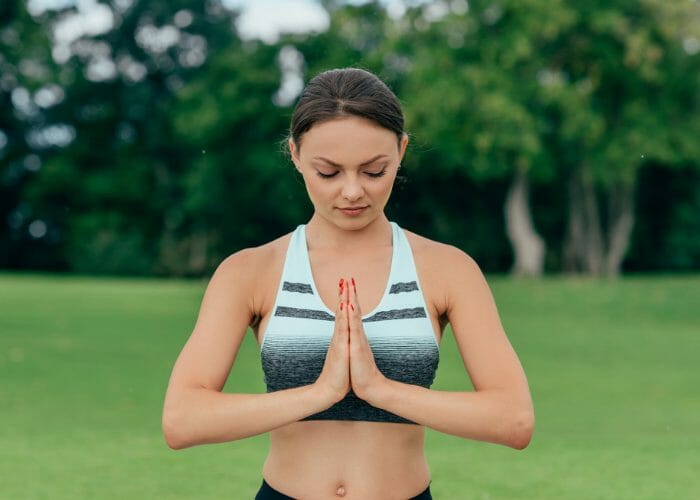
- Try this if you want to reduce stress
- Level of difficulty: Beginner
How this breathing exercise will help:
When we are stressed, our body has an automatic fight-or-flight response. It sets our nerves on end. We spend our energy trying to keep ourselves together during very trying times instead of learning how to deal with the problem at its source.
Pranayama breathing reaches the part of our nervous system that is not accessible through regular, shallow breathing. It internally combats our fight-or-flight response and stimulates calm.
Thus, pranayama helps us take calm control over our breath, our minds and our bodies, from an automatic place: our nervous system. Ujjayi is a form of the basic 3-part diaphragmatic breathing with a light “ocean” sound on each exhale. It tends to be used during movements to help keep a meditative, mindful breath in action.
Steps for how to start:
- Lengthen your breath by taking a deep inhale with a matching exhale.
- Start to fill your abdominal cavity with air. Then, expand your rib cage with air up to the top of your head. Note: do not raise your shoulders with the inhale, but allow the breath to fill your upper chest, neck, and headspace.
- With your mouth closed, tighten the back of your throat the same way you do when you are fogging up a mirror or whispering loudly. Continue breathing, making this subtle sound with each exhale.
- Focus on the breath, its depth as a complete inhale and exhale, and on the ujjayi sound.
- Practice for 5 minutes in the morning and evening.
4. 4-7-8 Breathing Technique
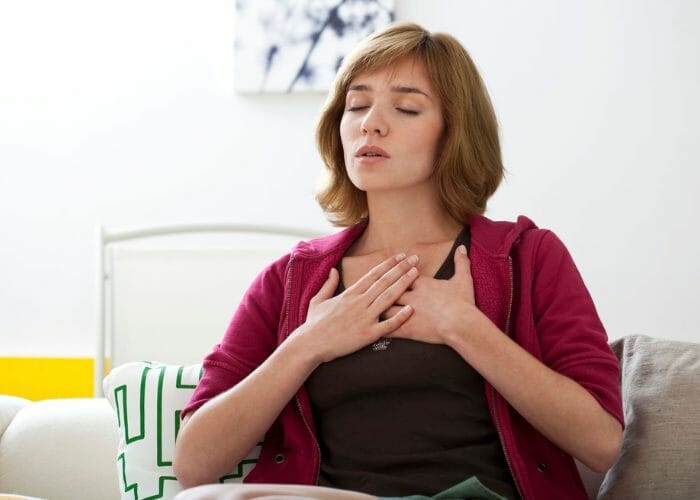
- Try this if you have insomnia
- Level of difficulty: Beginner
How this breathing exercise will help:
The 4-7-8 breathing technique must be done twice a day. To begin, do only one set for the first month of practice. After the first month, increase in increments to eight sets per session. The maximum number of breathing sets of the 4-7-8 technique is eight sets per session.
Steps for how to start:
- This breathing technique is inhaled through the nose and exhaled through an open mouth, as though blowing out a candle very gently.
- Inhale to a count of four.
- Hold your breath for a count of seven.
- Exhale through your mouth to a count of eight.
- Inhale through your nose immediately after the exhale.
- Upon completing a set of 4 breaths, give yourself a moment to recover and refocus before you continue with your day.
5. Calming Breathing Exercise for Anxiety
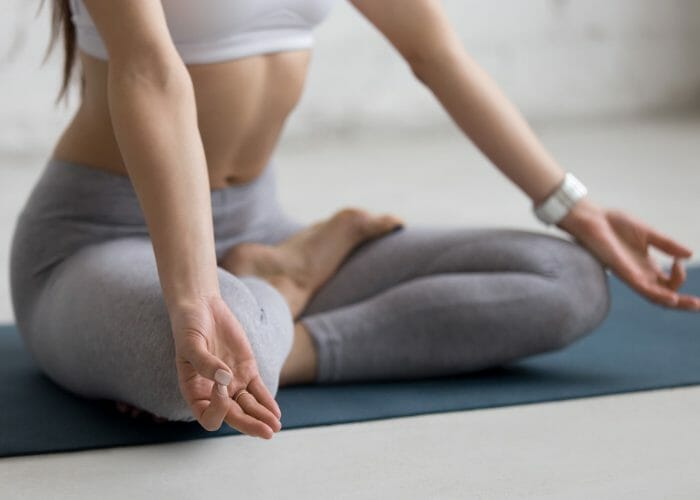
- Try this if you feel nervous, anxious or panicked
- Level of difficulty: Intermediate
How this breathing exercise will help:
Anxiety is often accompanied by shortness of breath, hyperventilation, and a tight feeling in your chest. This breathing technique will help you take control of those difficult and panicked moments.
Do it as a daily practice as well as during a panicked moment, to help focus and control your mind. As a daily practice, inhale and exhale through your nose. However, during a panic attack or times of undue stress, you can deepen your breaths through your mouth. However, the ultimate goal is to inhale and exhale through your nose.
Steps for how to start:
- Begin to deepen and lengthen your inhale.
- Start to breathe deeply into your abdomen.
- Concentrate on filling your abdomen with air.
- As you exhale deeply, let loose all the air in your rib cage and then push all the air out of your abdomen.
- On each exhale, start a backward count from 5.
- Inwardly focus on your breathing, and notice your body’s physical response to the breathing as it starts to relax. Concentrate on those effects.
- Continue this technique for several minutes, up to ten minutes, as necessary.
6. Relaxing Breathing Exercise for Restful Sleep
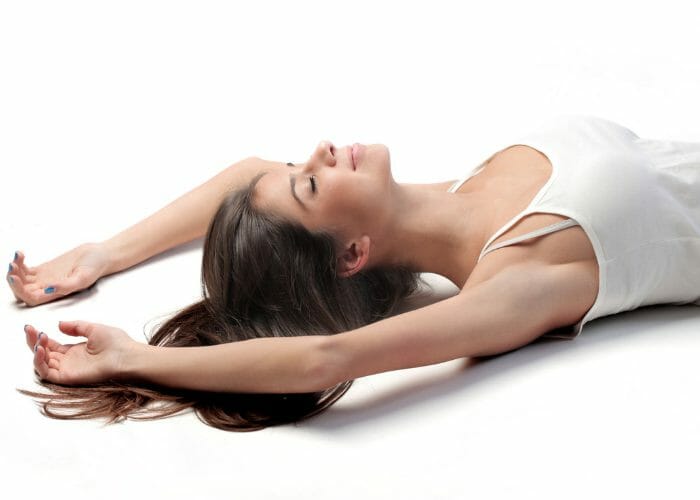
- Try this if you can’t sleep
- Level of difficulty: Advanced
How this breathing exercise will help:
This technique mimics our own deep breathing patterns during deep sleep. It encourages a deep inhale, followed immediately by a longer exhale and holding the exhale for a few seconds before the next inhale.
It is difficult to do at first, so you’ll have to practice it before you can use it regularly. Your conscious body actually rejects this breath pattern until you have the capacity to do it at will!
Steps for how to start:
- Sit upright with your spine in an S-curve and your abdomen tight. Or, lie in the prone position, with your shoulder blades tucked under, chin tucked in, abdomen tight, and arms flopped open at your sides with your palms up.
- Slowly increase your inhales and exhales to a steady and even count, with no pauses between them.
- Gradually begin to lengthen your exhale by two extra counts, and hold your exhale for another two counts.
- Continue breathing with extended exhales until you feel your body breathing this way naturally.
- Allow yourself to feel more relaxed.
- As you grow more capable with this technique, use it in bed before trying to go to sleep, or anytime you wake up during sleep and want to go back to sleep.
7. Lion’s Pose

- Try this if you want to exercise facial muscles
- Level of difficulty: Advanced
How this breathing exercise will help:
This breathing exercise is called Lion’s pose (or simhasana), a little-used yoga pose that exercises the facial muscles. Bell’s palsy is a temporary paralysis of one part or half of the face and can benefit from regular exercise. Lion’s pose can help rehabilitate your facial muscles while simultaneously giving you a means to reduce stress.
This technique forcefully exhales with a silent but quick “HAAA” sound until all of the breath is completely exhaled from your abdomen. While you exhale, you open your mouth as wide as possible, sticking out your tongue until the tip touches your chin, opening your eyes as wide as possible, extending your neck fully, and splaying your fingers as wide as possible.
The goal is to hold the pose for thirty seconds after the initial exhale. You will be breathing deep breaths through your nose for that time. This pose is very difficult to do, which is why this is an advanced technique. Until you reach that goal of 30 seconds, hold it for as long as possible. Practice this technique for five to six sets, twice a day.
Steps for how to start:
- Sitting upright with your spine in an S-curve, either on a chair or on the floor with your legs underneath you and your toes pointing behind you.
- Place your hands on your knees.
- Take several repeated inhales and exhales, deepening your breath in increments.
- As you prepare to do the Lion’s pose, remember each part of the pose as it pertains to your eyes, face, tongue, neck, and You may do each part separately until you have learned this pose.
- Inhale completely, then forcefully exhale and come into Lion’s pose. Exhale with a loud whisper of “HAAAA” until all of the air is expelled from your abdomen.
- At the same time as you exhale, open your mouth as wide as possible. Extend your tongue until the tip touches your chin.
- Open your eyes as wide as possible and look up. Extend your neck up and out. Keeping your hands on your knees, splay your fingers wide.
- Hold this pose for 5 seconds or as long as possible until you can hold it for 30 seconds.
- Repeat 5-6 times.
Note: there will be drool, so be prepared!
8. Breathing technique for COPD and Asthma
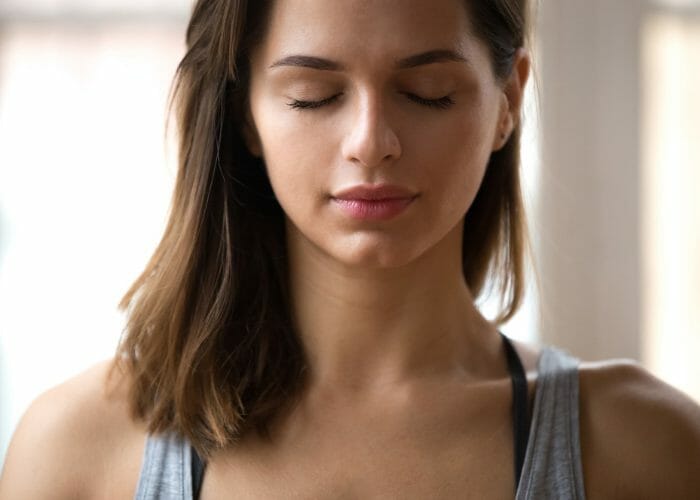
- Try this if you have difficulty breathing or chronic shortness of breath
- Level of difficulty: Beginner
How this breathing exercise will help:
Doing this exercise will help you control your breath. As you continue with your breathing practice, you should notice your muscles relax, and anxiety levels decrease.
If it is hard to breathe during this exercise or if you feel panicked, stop immediately. But continue trying to practice these exercises 10-12 times per day.
Steps for how to start:
- Inhale through your nose up to a count of 2.
- Purse your lips into a tight thin line with a tiny peephole in the center and exhale through pursed lips to a count of 2 or more.
- Exhale through pursed lips until all of the air is expelled from your lungs.
- Try to lengthen and deepen your breaths, if possible.
- Do this for a set of 5 breaths, and increase it to 8-10 sets, many times per day.
9. Strengthening Breath Exercise to Increase Lung Capacity
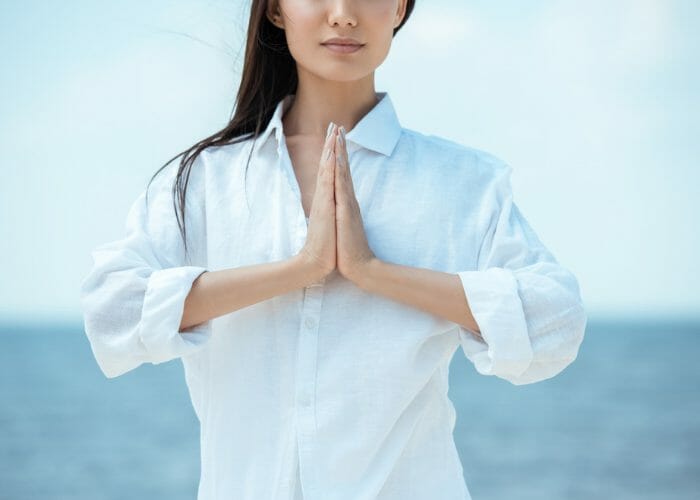
- Try this if you want to strengthen your lungs
- Level of difficulty: Intermediate
How this breathing exercise will help:
This breathing exercise will help you expand your lungs. The expansion will increase your capacity to hold your breath, to control your exhales, and to increase the duration of each breath.
Steps for how to start:
- Stand upright with your back in its natural S-curve, abdomen tight.
- Exhale all the oxygen from your lungs.
- Breathe in slowly with as much air as possible.
- Hold the inhale in for ten seconds.
- Exhale slowly.
- Repeat this exercise for 10 minutes.
Expert Tips for Mastering Deep Breathing
- Practice different techniques. Make sure to incorporate many different breath practices into your regimen. If you are trying to cure insomnia, practice breathing techniques for both calming and energizing your body. This way, you will increase your capacity to do both things and have more control over both sides of the spectrum.
- Do it everywhere. Get active with your breathing practice. Practice it while you are doing other things: walking, shopping, working, cooking, or any other normal activity.
- Practice, then practice some more. All of these techniques require very little time and can be done anywhere. So, do them as much as possible! Begin your day with them, and end your day by doing them before going to sleep. Anything in between is a bonus!
- Use them in times of stress. Remember that these exercises don’t need you to schedule “quiet time” to do them. In fact, some of them should be done in the middle of the most hectic time, the most anxious or panicked time, during arguments, or when you are experiencing cravings. They will give you time to cool off, both physically and mentally, and to stabilize your emotions.
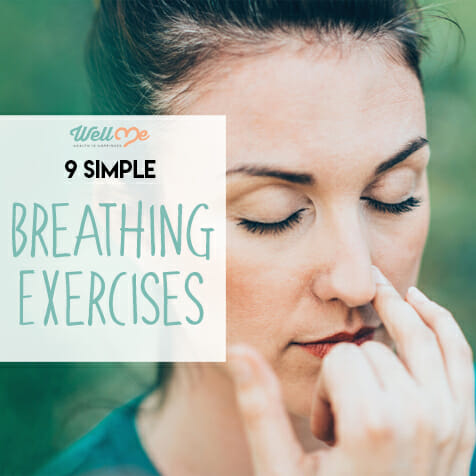
Conclusion
Once you start to deepen your breathing, you can try new techniques with different intentions. Whether it be to manifest the law of attraction or to visualize new stages of life, breathing exercises can improve your wellbeing and help you achieve your goals!
Read Next: Boost Your Butt With This Simple Booty Band Workout

